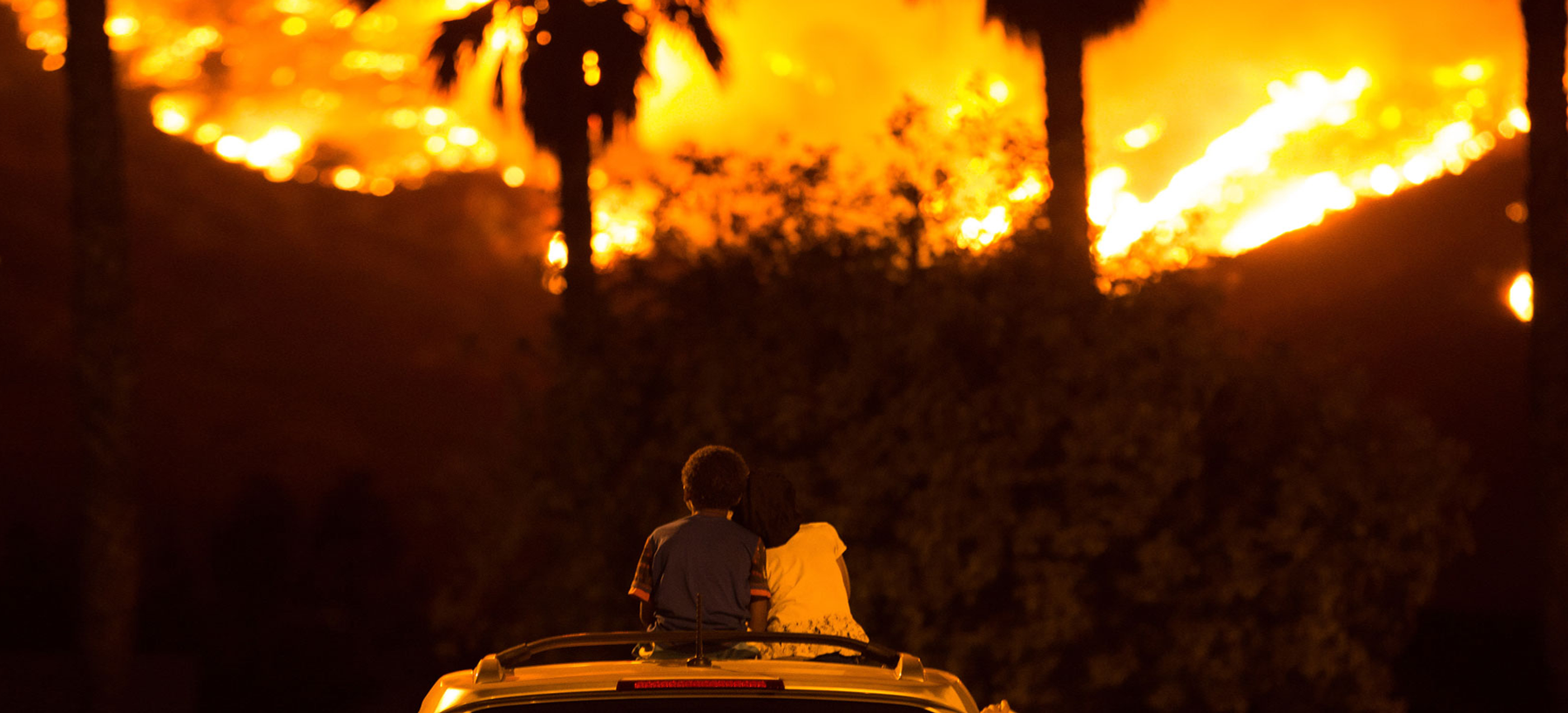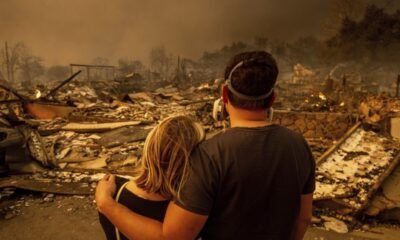Climate Journalism
LA Wildfires. A Deadly Mix Of Nature’s Fury And Human Shortfalls—Destruction, Tragedy, And The Lessons We Must Learn
Published
9 months agoon

Los Angeles County continues to real under devastating wildfires, with California Governor Gavin Newsom calling for an independent investigation into the failure of hydrants to maintain water pressure during the critical phases of firefighting this week. A combination of natural and human factors has pushed the county’s resources to their limits, furthering the destruction.
Wildfires Progress and New Risks
Despite progress in containing several blazes, fresh evacuation orders and road closures issued late Friday illustrate the persistent dangers for both residents and first responders.
The Palisades Fire, which has already consumed over 21,000 acres, expanded eastward Friday evening, threatening the Mandeville Canyon area. Fire crews and aircraft have been redirected to the region in an urgent effort to prevent further spread. “The fire can still change direction quickly,” said Los Angeles Fire Department spokesperson VanGerpen. “Right now, it is moving fast towards the east.”
Ten aircraft and additional strike teams have been deployed to combat the fire in Mandeville Canyon. Although the Red Flag Warning for high winds expired Friday evening, Cal Fire warned that winds could intensify over the weekend, potentially leading to a Santa Ana wind event next week — a scenario that could worsen the ongoing crisis.

Scale of Damage
Preliminary assessments by Cal Fire estimate that over 10,000 structures have been damaged or destroyed by the Eaton and Palisades fires alone. This figure, which includes homes, sheds, and other buildings, is expected to rise as damage inspectors continue their evaluations.
The latest status of major fires in Los Angeles County is as follows:
—Palisades Fire: 21,596 acres burned, 8% contained
—Eaton Fire: 14,117 acres burned, 3% contained
—Kenneth Fire: 1,052 acres burned, 50% contained
—Hurst Fire: 771 acres burned, 70% contained
—Lidia Fire: 395 acres burned, 98% contained
—Archer Fire: 19 acres burned, 0% contained
—Resource Constraints and Leadership Challenges
Amid the firefighting efforts, Los Angeles Fire Chief Kristin Crowley spoke about the impact of recent budget cuts on her department’s ability to combat the wildfires effectively. The city slashed the fire department’s budget by $17 million, eliminating critical civilian positions such as mechanics.
“Over 100 fire apparatus are out of service,” Crowley said, adding that the department is “no longer able to sustain where we are.”
Mayor Karen Bass, who met with Crowley on Friday, has faced criticism for the budget cuts. However, her office denied reports of Crowley’s dismissal, stating, “This is false.” Neither Bass nor Crowley attended a scheduled news conference about the wildfires Friday evening, leaving police department officials to address the public instead.
The Fires Unleashed
The Palisades Fire ignited on January 7, 2025, in the Santa Monica Mountains, quickly consuming over 21,000 acres. Fueled by powerful Santa Ana winds, the fire spread rapidly, destroying the Pacific Palisades neighborhood and threatening nearby Malibu. As of January 10, the fire remained largely uncontained, with over 5,300 structures reported destroyed or damaged.
Concurrently, the Eaton Fire began in the San Gabriel Mountains, near Altadena, on the same day. By January 8, it had expanded to over 14,000 acres, with zero containment. The fire prompted evacuations in multiple communities, including Altadena, Pasadena, and parts of Glendale. As of January 10, the fire had destroyed or damaged over 8,000 structures.

Human Impact and Evacuations
The wildfires have claimed at least 11 lives and forced nearly 180,000 residents to evacuate. Among the victims were a man holding a garden hose and a father at his son’s bedside, indicative the personal tragedies amid the disaster.
Evacuation orders affected numerous communities, with some residents abandoning their vehicles as flames approached. The Los Angeles Police Department deployed around 140 officers to assist with evacuations and manage traffic congestion. In certain areas, evacuation orders were expanded to include parts of Santa Monica and the San Fernando Valley.
Infrastructure Challenges
A critical issue during the firefighting efforts was the failure of fire hydrants to maintain adequate water pressure. Approximately 20% of hydrants in the Pacific Palisades area ran dry, hindering firefighters’ ability to combat the flames effectively. This problem was heightened by a 20% reduction in the Los Angeles Fire Department’s budget, which had eliminated civilian positions such as mechanics, leading to a shortage of functional firefighting equipment.
Political and Administrative Responses
The budget cuts to the fire department were part of a broader strategy to reallocate funds toward addressing homelessness. However, this decision faced significant criticism. Dr. Patrick Soon-Shiong, the billionaire owner of the Los Angeles Times, condemned Mayor Karen Bass for the cuts, stating that it was “a bad call” and emphasizing the need for accountability among leaders.
Additionally, Mayor Bass faced scrutiny for her absence during the initial stages of the crisis due to a trip to Ghana, which delayed vital decision-making during the wildfires. This absence further escalated the situation, as timely responses were crucial in the early hours of the disaster.
Economic and Cultural Impact
The economic damage from the wildfires is estimated to be up to $57 billion, making it potentially the most costly fire disaster in California’s history.
The fires have destroyed thousands of homes, including those of celebrities such as John Goodman, Leighton Meester, Paris Hilton, and Anthony Hopkins. Important cultural sites, including the Getty Center, have also been affected, leading to the closure of several landmarks and the postponement of multiple events.
Environmental and Health Concerns
The dense, choking smoke from the fires has plagued the city, leading to air quality advisories and health concerns for residents. The fires have also caused significant environmental damage, destroying habitats and affecting local wildlife. The long-term ecological impact remains to be fully assessed, but the immediate effects have been devastating.

The Last Bit
As firefighters continue to battle the blazes, the community remains resilient. Efforts are underway to provide support to those affected, including temporary housing, financial assistance, and mental health services.
The events of January 2025 shiow the critical need for strong emergency preparedness, adequate funding for fire departments, and proactive measures to address climate change, which contributes to the increasing frequency and severity of wildfires.
In the aftermath, there is a renewed focus on strengthening infrastructure, improving communication systems, and ensuring that resources are allocated effectively to prevent and mitigate future disasters. The lessons learned from this tragedy will be instrumental in shaping policies and strategies aimed at safeguarding communities against the devastating effects of wildfires
Likewise, experts caution that while nature may have ignited the flames, human decisions have amplified the damage. Addressing infrastructure failures, resource allocation, and leadership gaps will be critical in minimizing future wildfire impacts.
For now, Los Angeles County remains on high alert, with crews working tirelessly to contain the fires and protect communities from further devastation.
You may like
-


Germany’s Friedrich Merz’s Big Balancing Act—Trump, Borders & Europe’s Future. Can He Deliver?
-


Wheat Crop At Risk As February May Be Warmer In India. How Climate Change Is Resulting In ‘Persistent’ Food Inflation Crises In India?
-


World’s Largest Iceberg Threatens South Atlantic Island, As Great Barrier Reef Faces Catastrophic Coral Bleaching. Why Is Humanity Hell-Bent On Turning A Living Earth Into A Dead Mars
-


Why Donald Trump Wants Greenland—Melting Ice, Mineral Gold Rush…And Unfortunately Global Climate Disaster
-


LA Burnt: War Of Words Between Trump And Biden Administration, Fire Hydrants Ran Out Of Water, And The Collateral Damage-$57 Billion In Damages. Who Is Responsible For The Inferno?
-


Wars, Conflicts, And Climate Change. A Huge Cost To Be Paid By Humanity Ultimately As Climate Change Is Surely “Not A Priority”!
